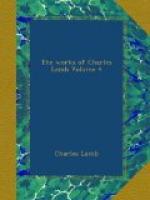“For much imaginary work was there,
Conceit deceitful, so compact, so kind,
That for Achilles’ image stood his
spear,
Grip’d in an armed hand; himself
behind
Was left unseen, save to the eye of mind:
A hand, a foot, a face, a leg, a head,
Stood for the whole to be imagined.”
[Footnote 1: At the late Mr. Hope’s, in Cavendish Square]
This he well calls imaginary work, where the spectator must meet the artist in his conceptions half way; and it is peculiar to the confidence of high genius alone to trust so much to spectators or readers. Lesser artists show everything distinct and full, as they require an object to be made out to themselves before they can comprehend it.
When I think of the power displayed in this (I will not hesitate to say) sublime print, it seems to me the extreme narrowness of system alone, and of that rage for classification, by which, in matters of taste at least, we are perpetually perplexing, instead of arranging, our ideas, that would make us concede to the work of Poussin above mentioned, and deny to this of Hogarth, the name of a grand serious composition.
We are forever deceiving ourselves with names and theories. We call one man a great historical painter, because he has taken for his subjects kings or great men, or transactions over which time has thrown a grandeur. We term another the painter of common life, and set him down in our minds for an artist of an inferior class, without reflecting whether the quantity of thought shown by the latter may not much more than level the distinction which their mere choice of subjects may seem to place between them; or whether, in fact, from that very common life a great artist may not extract as deep an interest as another man from that which we are pleased to call history.
I entertain the highest respect for the talents and virtues of Reynolds, but I do not like that his reputation should overshadow and stifle the merits of such a man as Hogarth, nor that to mere names and classifications we should be content to sacrifice one of the greatest ornaments of England.




